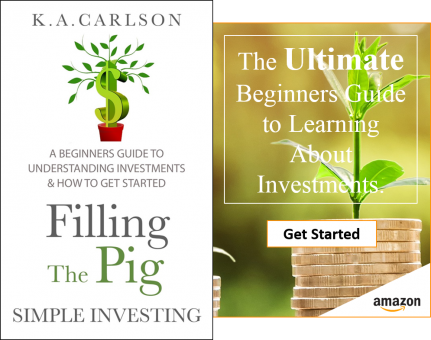It’s one of the main reasons most people don’t start investing. The perspective that in order to start investing you need a lot of money. This misconception inevitably adds to the confusion surrounding investing so for most the topic becomes an afterthought when it comes to managing their finances. However, I can tell you from past experience that investing is simple, and getting started requires a minimum to invest. To get started you just need to understand the options that are available to you. So, how much money do you need to start investing? Here are 6 ways to start investing with a little money.
First Things First
When discussing the topic of investing were talking about taking the money you already have – cash, and putting it somewhere where you can make more money. For some investing may involve real estate, or participating in a business venture. For our purposes we will focus on the more traditional approach, investing through securities like CDs, stocks, or mutual funds.
It’s about taking the money you have in a checking or savings account that earns little or no interest, or maybe that cash stashed under your bed and putting it into an investment vehicle with the expectation of making more money.
But let’s be clear about two key points.
I am not talking about using your emergency fund for investing. An emergency fund is there for a specific reason – emergencies.
Related Post:
- How to Open a Brokerage Account Online, In 4 Simple Steps
- Understanding Robo-Advisors and Automated Investing Video
- How to Track Stocks and Mutual Funds using Yahoo Finance (Video)
- 10 Successful Money Management Tips to Live By – from a 52-Year-Old
- The Art of Being a Cheapskate – How I Successfully Manage My Budget
And I am not recommending you use the available cash that you have been saving for a car or down payment on a home.
Any form of investing requires some risk. Your emergency fund and having cash available for large planned purchases is critical to staying out of debt. Beyond those funds, the extra money you have can be used to start investing.
How Much Money Do You Need to Start Investing?
Choosing the right investment vehicle will vary depending on a number of factors, your current financial situation, your age and your propensity to tolerate risk. However, regardless of where you are financially here are 6 ways to start investing with a little money.
Note: at the end of this article are links to various online resources where you can get an initial preview of what is available for these investment options.
High Yield Savings and Certificate of Deposit (CD) accounts
They aren’t flashy and it’s unlikely you will become a millionaire throwing your cash into these accounts, but they do provide another means of making more money. As opposed to leaving your money in a low-interest saving or checking account.
High yield savings accounts are sometimes referred to as Money Market Accounts (MMA). They generally provide a slightly higher interest rate than a traditional savings account. The interest rate you earn on your balance will vary depending on the minimum amount you deposit and your average monthly balance. MMA’s are provided at most banks and credit unions.
Minimum to Invest: As low as $500.
Certificate of Deposits (CDs) will typically pay a higher interest rate than an MMA. The higher interest rate is reflected based on the amount of money you deposit and the term of the CD. You won’t want to park cash in a CD when you may need the money prior to the maturity date of the CD.
Minimum to Invest: As low as $100 to get started, available at most financial institutions.
Related Posts:
Employer-Sponsored 401(k)
A 401(k) is one of the easiest ways to start investing. In addition, if your employer is providing a company match then you have the opportunity to increase your overall contributions to your 401(k), which means more money to invest. But the best part of contributing to a 401 (k) is that you can do all of it through payroll deduction.
Payroll deduction takes away the manual, “how much money should I invest” decision-making process. It’s a “set it and forget it” means of investing. In most cases, a traditional 401(k) will provide you with the opportunity to contribute as a percentage of your paycheck.
For example. In 2015 the average household income in the United States was @$55,000. Contributing 1% of $55,000 would be equivalent to $550 annually. If you are paid bi-weekly (every two weeks) your investment in your 401(k) would be equivalent to $21.14 per paycheck. A small sum to start investing.
Minimum to Invest: As low as 1% of your salary.
Individual Retirement Account (IRA)
IRA’s are a great retirement vehicle if your employer does not provide a 401(k) plan. Individual retirement accounts provide many tax benefits and come in a variety of options based on your retirement goals.
You can establish an IRA account through your local bank or through a host of asset management companies like Fidelity, Vanguard or T. Rowe Price. Online brokerage firms like E*TRADE also provide IRA accounts. In some cases, similar to a 401(k) account you can leverage payroll deduction as a means of contributing. Robo-advisors like Wealthsimple are another option for opening an IRA account.
Minimum to Invest: This will vary depending on what type of IRA account you open, but many banks and asset management companies like Fidelity or Vanguard have no minimums to open a simple IRA account.
Related Posts:
- What is a 401(k) – Save for Retirement Paycheck to Paycheck
- What is an IRA?
- Lower Your Taxes and Start Investing by Opening a Traditional IRA Account For Retirement
- 3 Reasons You Should Contribute to Your Employer’s 401(k) Plan so You Can Retire Early
Mutual Funds and ETFs
Mutual funds are a great way to get exposed to the world of investing. Most mutual funds are actively managed (so you don’t have to manage the investment yourself) and they provide a level of portfolio diversification, which helps lower overall risk. There are literally thousands of mutual funds with different investment goals, which means regardless of what your investment strategy is, there is likely a mutual fund for you.
An Exchange Traded Funds (ETF) is similar to a mutual fund. ETFs are a diverse portfolio of securities. However, unlike mutual funds, ETFs can be traded similar to a stock.
Minimum to Invest: Most mutual funds require an initial investment of $2,500-$3,000 and then additional contributions can be made in $100 increments. However, if you are investing in a mutual fund as an IRA the minimums could be as low as $1,000. ETFs generally have no minimum, other than the cost of a trade.
Stocks
Stocks are probably the most misunderstood investment vehicle in regards to understanding how much money is required for you to start investing. Much of this perception is created by the fact that the stock market is so visibly observed in the media it creates the perception of being a very large complex maze. From an investing perspective this makes it look and feel “big” and big generally means lots of money.
The reality is that if you wanted to purchase a single share of a company’s stock you could do so based on the cost of the share and the transaction cost associated with the purchase.
For example: If you feel Walmart is a good investment because of their future growth opportunities, you could purchase a single share of stock for $79.12 (as of 9/26/2017). If you purchase the stock via an online brokerage firm you will pay a transaction fee of @$4.95-$9.95. For less than $100 you can become an owner in Walmart.
Related Posts:
- What is a Mutual Fund?
- What is a Stock?
- Exchange-Traded Fund (ETF)?
- Track Stocks and Mutual Funds using Yahoo Finance (Video)
Of course, the number of shares you purchase, the cost of each transaction and the growth of your Walmart investment will dictate whether your investment turns out to be a profitable venture. However, the cost to start investing is low.
Minimum to Invest: The cost of the stock, plus the transaction fee.
Robo, Automated, Automatic Investing
Regardless of whether you call it robo, automated or automatic investing these services have become more popular over the past few years for two reasons. First, they’re a direct result of the advances in technology and the reduced cost using the technology to create financing applications. Second, these applications have simplified the investment world from the perspective of portfolio management, which has made it easier for the average consumer to start investing.
There are a number of different ways automated investing works, but in general, they are all similar from this perspective. Within the specific application, you determine your investment goals based on risk, timeline and specific investment interests – you establish guidelines. Once you establish your goals you fund your account through a lump sum or periodic investment. The application then automatically allocates your funds based on your investment guidelines.
Acorns is a popular automated investing application. It’s a great example of how automated investing works when you have a small sum of money. Acorns works like this.
- You link your checking account(s) to the Acorns application.
- As you make purchases, Acorns rounds your transactions up to the nearest dollar.
- The roundup process creates “spare change” from your account, which is then used by the Acorn’s application to make investments based on the financial goals you defined within the application.
Minimum to Invest: This will vary based on the automated investing application, but in the case of Acorns it’s literally cents on the dollar each time you make a purchase. Wealthsimple another robo-advisor has no minimum to open an account and has very low management fees.
Learn more about robo-advisors by watching this video, Understanding Robo-Advisors, and Automated Investing Video
Learn More to Start Investing
The need or motivation to start investing will vary based on an individual’s financial environment and their goals. However, the amount of money needed to start investing shouldn’t be a barrier. Even if your current financial environment does not allow you to start investing today, it’s likely that at some point you will. Here are additional resources you can use to learn more and get a perspective on what it takes to start investing.
Helpful Resources:
- How to Open a Brokerage Account Online, In 4 Simple Steps
- Motley Fool – Stock Advisor
- Wealthsimple – Automated Investing, Open an IRA Account, No Account Minimum
- Acorns
- Personal Capital – All Your Financial Tools in One Place
What was your first investing experience? Comment below.


